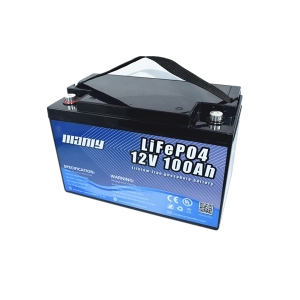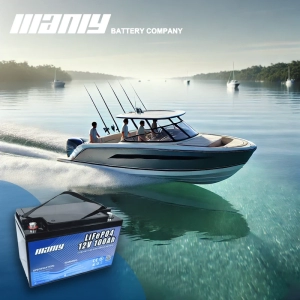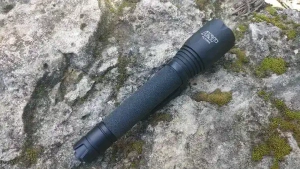Kann ich einen Lithium-Akku mit einem normalen Ladegerät aufladen?
Inhaltsverzeichnis
- Kann ich einen Lithium-Akku mit einem normalen Ladegerät aufladen?
- Auswahl des richtigen Lithium-Batterieladegeräts: Ladeunterschiede zwischen Lithium- und SLA-Batterien verstehen
- Wie Lithium batterien auf ein SLA-Ladeprofil reagieren
- Könnte ein SLA-Ladegerät einer Lithium batterie schaden?
- Kann ich einen Lithium-Akku mit einem Netzteil aufladen?
- Abschluss
- Erfahren Sie mehr über Batterie

Auswahl des richtigen Lithium-Batterieladegeräts: Ladeunterschiede zwischen Lithium- und SLA-Batterien verstehen
Understanding how lithium batteries and SLA batteries absorb charge is essential when choosing the right type of Lithium-Batterieladegerät. Die Ladeprofile dieser Akkus unterscheiden sich deutlich. SLA-Batterien folgen typischerweise einem dreistufigen Prozess: Konstantstrom, Konstantspannung (auch Absorptionsstufe genannt) und Erhaltungsladung. Im Gegensatz dazu arbeiten Lithium-Batterieladegeräte nur mit zwei Stufen: Konstantstrom und Konstantspannung.SLA-Batterieladevorgang
For an SLA battery, the first stage is the constant current phase, where the battery receives most of its charge. For example, a 12V 20Ah SLA battery may take around 3-4 hours to reach 80% of its total charge capacity. Once this level is reached, the process shifts to the constant voltage or absorption stage. This stage completes the final 20% of the charge but can take as long as the first stage, making up about 50% of the total charging time. The final stage, float charging, keeps the battery at full charge to prevent self-discharge. While this helps maintain the battery’s lifespan, it also extends the total charging time.Warum Lithium batterien schneller aufgeladen werden
Charging a lithium battery is much simpler and quicker. With a lithium battery charger, the first stage (constant current) brings the battery up to 99% of its charge. The remaining 1% is topped off in the second stage, constant voltage, which is much shorter than the absorption stage used for SLA batteries. This streamlined process means lithium batteries can be fully charged up to three times faster than similar-capacity SLA batteries.For example, a 12.8V 20Ah lithium battery can reach almost full capacity in about 2.5 hours, compared to over 6.5 hours for an equivalent SLA battery. This rapid charging capability makes lithium battery chargers a popular choice for applications like golf carts, marine systems, and backup power solutions, where minimizing downtime is essential.Spannungsprofile sind wichtig
One key difference between SLA and lithium batteries is their voltage profiles. A fully charged 12V SLA battery typically reaches around 12.7V, while a lithium battery can reach up to 13.4V when fully charged. This narrow voltage range in lithium batteries means that using a standard SLA charger can lead to either overcharging or undercharging. To prevent these issues, you need a universal lithium battery charger that is specifically designed to meet the precise voltage requirements of lithium batteries.The best way to charge lithium batteries is to use a dedicated li ion battery charger that follows a CC/CV (Constant Current/Constant Voltage) charging algorithm. This ensures the battery is charged safely and efficiently. Unlike SLA chargers, which may continue to trickle charge, a lithium battery charger stops charging as soon as the battery reaches full capacity, preventing potential damage from overcharging.Wie Lithium batterien auf ein SLA-Ladeprofil reagieren
One common question many people have is whether a lithium battery can be safely charged using an SLA (Sealed Lead Acid) charger. The short answer is: Yes, but there are conditions. To understand why, it’s crucial to look at how lithium batteries absorb charge compared to SLA batteries, especially when using a charger designed for a different type of battery.Wie Lithium batterien auf SLA-Ladeprofile reagieren
The main issue when charging a lithium battery using an SLA charger is the difference in the charging curves. Most SLA chargers are set to operate at a constant voltage range between 13.8V to 14.7V. If a lithium battery is charged at the lower end of this voltage range, around 13.8V, it can still reach up to 95% of its total capacity within 90% of the total charging time. This is because the lithium battery’s internal resistance is lower, allowing it to take in more energy more quickly.However, if the charger operates at a higher voltage, around 14.6V—which is the typical voltage used for AGM batteries—the lithium battery can reach up to 99% capacity in just 95% of the charging time. This means that at higher voltages, the charging process is even more efficient, bringing the lithium battery to almost full capacity quickly.Längere Ladezeit mit einem SLA-Ladegerät
While a lithium battery can be charged using an SLA charger, the charging time will still be longer than if a dedicated lithium battery charger were used. For example, a 20Ah lithium battery might take around 2.5 hours to charge using a standard lithium battery charger. However, the same battery could take up to 5 hours to charge fully using an SLA charger. This is because the SLA charging profile is not optimized for lithium batteries, leading to less efficient absorption of energy during the constant voltage phase.Despite the longer charging time, a lithium battery will still charge faster on an SLA profile than a typical SLA battery. This is due to the nature of lithium batteries, which can absorb more energy during the bulk charging stage and require less time to reach higher states of charge. So, even with a non-optimized charger, lithium batteries still outperform their SLA counterparts when it comes to overall charging speed.Mögliche Risiken bei der Verwendung eines SLA-Ladegeräts
Although it is technically possible to use an SLA charger for a lithium battery, there are a few important considerations. First, the SLA charger must not have a desulfation mode or a dead battery detection feature. Desulfation mode uses high voltage pulses to restore over-discharged SLA batteries. These high voltage pulses can damage a lithium battery or cause its Battery Management System (BMS) to shut down. Similarly, a dead battery detection mode might misinterpret a lithium battery in protective mode as a dead battery and fail to initiate the charging process.Additionally, the lithium battery charge voltage is more sensitive compared to SLA batteries. Using a charger that outputs voltage outside the acceptable range can harm the battery cells, leading to reduced lifespan or even permanent damage. This is why using a dedicated lithium battery charger or a universal lithium battery charger designed to handle these specific voltage requirements is always the best way to charge lithium batteries.Ladeeffizienz bei verschiedenen Spannungsbereichen
The voltage range of the SLA charger will also affect how efficiently a lithium battery charges. At the lower end of the voltage range (13.8V), the lithium battery will charge relatively quickly to 95% SOC, even faster than an SLA battery can reach 80% SOC. When charged at the higher end (14.6V), which is common for AGM batteries, the lithium battery can reach 100% SOC in a shorter time, further highlighting its superior charging capabilities compared to SLA batteries.Overall, while using an SLA charger is not ideal, it can work for charging lithium batteries if no other option is available. However, for the best results and to ensure the longevity of the battery, it’s always recommended to use a dedicated li ion battery charger that can meet the specific charging needs of a lithium battery. This approach minimizes the risks and guarantees optimal performance, making it a safer and more efficient solution in the long run.Könnte ein SLA-Ladegerät einer Lithium batterie schaden?
If you’re using an SLA charger to charge a lithium battery, you might wonder whether it will cause damage. The answer largely depends on the specific features of the SLA charger and how the lithium battery is being used. While it is possible to use a standard SLA charger without immediate harm, several key factors must be considered to prevent long-term damage.Die Risiken der Verwendung eines SLA-Ladegeräts verstehen
The primary concern when using an SLA charger for a lithium battery is whether the charger has specific modes designed for SLA batteries, such as desulfation or float charging. Desulfation mode, which is intended to restore over-discharged SLA batteries by sending high-voltage pulses, can be highly damaging to a lithium battery. These high pulses may trigger the Battery Management System (BMS) to shut down or, in some cases, physically damage the internal battery cells.Similarly, if the SLA charger includes a float charging mode, it could potentially harm the lithium battery. This mode continuously applies a small current to the battery even after it’s fully charged, which is unnecessary for lithium batteries. Due to their low self-discharge rate, lithium batteries do not need to be kept at 100% state of charge for long periods. Therefore, exposing a lithium battery to float charging over time could reduce its overall lifespan or even lead to overheating.Begrenzte Kapazität mit einem SLA-Ladegerät
One major issue you might encounter when using an SLA charger is that the lithium battery may not reach its full capacity. For example, a 20Ah lithium battery may only charge up to 90-95% of its total capacity using a standard SLA charger. This happens because SLA chargers operate at a slightly different voltage range than a lithium battery charger. This slight voltage difference means the lithium cells are not fully charged, which limits the usable capacity of the battery.If you’re using your lithium battery for a high-demand application, this could lead to reduced performance or shorter run times. However, for low-demand applications, you might not notice the difference. But if maximizing the capacity of your battery is essential, using a dedicated lithium battery charger is highly recommended.Täglicher Gebrauch vs. Langzeitlagerung
Another critical factor is whether the lithium battery is being used daily or if it will be left connected to the charger for extended periods. If you’re using the battery in a high-cycle application where it’s charged and discharged frequently, an SLA charger without desulfation or float modes may work without causing immediate damage. In these cases, the charger may not keep the battery connected long enough to trigger harmful effects.However, if the battery is going to spend long periods connected to the charger, it’s better to disconnect it once fully charged. Leaving a lithium battery on an SLA charger in storage can lead to unintended float charging, which might negatively impact battery health. Lithium batteries perform best when stored at around 50% state of charge, not at 100%, so it’s crucial to disconnect the battery if it’s not in use.Best Practices bei der Verwendung eines SLA-Ladegeräts
If you have no choice but to use an SLA charger for your lithium battery, keep the following best practices in mind to minimize potential risks:- Vermeiden Sie die Verwendung des Desulfatierungsmodus: Wenn Ihr SLA-Ladegerät über eine Desulfatierungsfunktion verfügt, verwenden Sie diese nicht. Die Hochspannungsimpulse können eine Lithium batterie beschädigen oder zum Abschalten des BMS führen.
- Nach dem Laden trennen: Um zu verhindern, dass die Batterie im Erhaltungslademodus bleibt, trennen Sie die Lithium batterie immer, sobald sie ihre volle Kapazität erreicht hat.
- Überwachen Sie die Spannungspegel: Überprüfen Sie während des Ladevorgangs regelmäßig die Spannung des Akkus, um sicherzustellen, dass sie den sicheren Wert nicht überschreitet. Wenn die Spannung des Akkus den empfohlenen Bereich überschreitet, beenden Sie den Ladevorgang sofort.
- Erwägen Sie ein spezielles Lithium-Ladegerät: Für die beste Leistung und Sicherheit wechseln Sie zu einem Lithium-Batterieladegerät. Ein Ladegerät für Lithium batterien verwendet das richtige Ladeprofil und verhindert potenzielle Schäden durch inkompatible Spannungseinstellungen.
Können Sie ein SLA-Ladegerät in Hochzyklusanwendungen verwenden?
In high-cycle applications, where the battery is frequently charged and discharged, using a standard SLA charger may not cause significant issues if the charger lacks harmful modes like desulfation. This is because the charger won’t be connected long enough to cause float charging or overheating. However, keep in mind that the battery might not reach its full capacity, reducing its effective run time between charges.Ultimately, using a lithium battery charger is always the safest option for maximizing battery performance and lifespan. While it is possible to use an SLA charger temporarily, it’s best to switch to a dedicated lithium battery charger whenever possible.Kann ich einen Lithium-Akku mit einem Netzteil aufladen?
The short answer is: Ja, können Sie a aufladenLithium BatterieDie Verwendung eines Labornetzteils erfordert jedoch besondere Vorsicht und Beachtung spezifischer Spannungs- und Stromeinstellungen. Im Gegensatz zu einem dediziertenLithium-BatterieladegerätDa ein Netzteil nicht über integrierte Sicherheitsfunktionen wie die automatische Stromregulierung während der Ladephasen verfügt, ist eine sorgfältige Überwachung unerlässlich, um ein Überladen oder eine Beschädigung der Batteriezellen zu verhindern.So verwenden Sie ein Netzteil sicher zum Laden
Charging a lithium battery involves following a CC/CV (Constant Current/Constant Voltage) charging profile. Most commercial lithium battery chargers are designed to automatically adjust the current during the charging process to ensure safe and efficient charging. A lab power supply, however, allows you to manually set the voltage and current limits. This makes it possible to charge a lithium battery, but there are a few critical steps to follow:- Stellen Sie die richtige Spannungsgrenze ein: Der erste Schritt besteht darin, sicherzustellen, dass Sie die Ausgangsspannung entsprechend dem spezifischen Typ der Lithium batterie einstellen. Bei Standard-Li-Ionen-Akkus sollte die Spannung auf 4,20 V pro Zelle eingestellt werden. Bei einer LiFePO4-Batterie (Lithiumeisenphosphat) liegt die Spannungsgrenze niedriger und liegt bei 3,65 V pro Zelle. Wenn Sie einen anderen Lithium batterietyp verwenden, überprüfen Sie unbedingt die vom Hersteller empfohlene Spannungsgrenze, bevor Sie fortfahren. Das Überschreiten des sicheren Spannungsbereichs kann zu Überhitzung oder dauerhaften Zellschäden führen.
- Stellen Sie die Strombegrenzung auf 1C ein: Der Ladestrom sollte auf maximal 1C eingestellt werden, wobei C die Kapazität des Akkus ist. Wenn Sie beispielsweise einen 2000-mAh-Akku laden, sollte der Strom 2 A nicht überschreiten. Eine zu hohe Stromstärke kann zu übermäßiger Hitze führen und möglicherweise die innere Struktur der Batterie beschädigen.
- Überwachen Sie den Ladevorgang genau: Beim Laden einer Lithium batterie über ein Netzteil ist es wichtig, die Spannung und den Strom während des gesamten Vorgangs zu überwachen. Während der Akku aufgeladen wird, nimmt er zunächst den maximalen Strom auf. Sobald die Spannung den Sollwert erreicht (z. B. 4,20 V pro Zelle bei einem Standard-Lithium-Ionen-Akku), beginnt der Strom zu sinken. Dies ist die Konstantspannungsstufe, in der der Strom allmählich abnimmt, wenn die Batterie ihre volle Kapazität erreicht.
- Stoppen Sie den Ladevorgang, wenn der Strom auf 3 % des Anfangswerts sinkt: Im Gegensatz zu einem handelsüblichen Ladegerät für Lithium batterien stoppt ein Netzteil den Ladevorgang nicht automatisch, wenn die Batterie voll ist. Um ein Überladen zu verhindern, beenden Sie den Ladevorgang, wenn der Strom auf etwa 3 % des anfänglichen Ladestroms abfällt. Wenn Sie beispielsweise den Anfangsstrom auf 2 A einstellen, trennen Sie die Batterie, sobald der Strom unter 0,06 A fällt.
Verwendung eines Netzteils im Vergleich zu einem speziellen Lithium-Batterieladegerät
While a power supply can be used to charge a lithium battery, it lacks many of the safety features found in a lithium battery charger. Commercial chargers are designed to handle the unique characteristics of lithium batteries, such as maintaining the precise lithium battery charge voltage and automatically switching off once the battery is fully charged. Using a power supply requires manual oversight, making it more prone to human error.Additionally, a commercial lithium battery charger will step down the current during the constant voltage phase, preventing unnecessary stress on the battery. A lab power supply, on the other hand, will continue supplying the set current, which can lead to overcharging if not monitored carefully. This is why it’s always safer to use a dedicated li ion battery charger whenever possible.Batterieladung mit einem Multimeter messen
To monitor the charge status of your lithium battery, you can use a multimeter to check the voltage. For example, if you’re charging a single Li-ion cell, the voltage should gradually rise from around 3.0V (empty) to 4.20V (full). If you’re charging a pack with multiple cells in series, multiply the per-cell voltage by the number of cells in the pack. It’s also possible to use the power supply’s display to track the charging current and voltage.When the charging current falls to nearly zero (e.g., below 0.01A), the battery is considered fully charged. At this point, disconnect the battery immediately to prevent overcharging.Vorsichtsmaßnahmen bei der Verwendung eines Netzteils
While it’s possible to charge a Lithium BatterieBei einer Stromversorgung müssen bestimmte Vorkehrungen getroffen werden, um die Sicherheit zu gewährleisten:- Sorgen Sie für den richtigen Ausgleich: Wenn Sie einen Akku mit mehreren in Reihe geschalteten Zellen laden, stellen Sie sicher, dass der Akku über ein BMS (Batteriemanagementsystem) mit Ausgleichsfunktionen verfügt. Dies hilft, jede Zelle auf der gleichen Spannung zu halten und eine Überladung einzelner Zellen zu verhindern.
- Vermeiden Sie Überladung: Lassen Sie eine Lithium batterie niemals an der Stromversorgung angeschlossen, nachdem sie die volle Ladung erreicht hat. Überladung kann dazu führen, dass der Akku überhitzt, anschwillt oder sogar ein Sicherheitsrisiko darstellt.
- Überwachen Sie die Temperatur: Behalten Sie während des Ladevorgangs die Temperatur des Akkus im Auge. Sollte der Akku ungewöhnlich heiß werden, brechen Sie den Ladevorgang sofort ab.



















